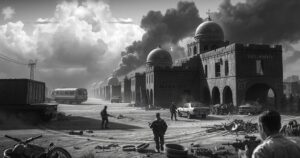U.S. Precision Strike on Iran’s Nuclear Facilities Marks New Chapter in Geopolitics

The U.S. executed a precision strike on Iran’s nuclear facilities, significantly impacting Tehran’s nuclear ambitions. The operation targeted the Fordow facility and involved sophisticated weaponry, marking a shift from diplomacy to military action. The implications for regional security and geopolitics are profound, with reactions and potential escalations expected from Iran and its allies.
The United States has made a bold move with a precision strike on Iran’s fortified nuclear facilities, signaling a dramatic shift in international relations. This operation involved the renowned B-2 Spirit bombers and marks a stark realization of what many had long anticipated. The attack signifies a breaking point in the belief that diplomacy could rein in Tehran’s nuclear ambitions. It is a bold new reality that has now overshadowed previous hopes for negotiation.
The centerpiece of this offensive was the Fordow facility, a heavily shielded site located near Qom. This bunker, until now deemed nearly untouchable, was hit in the early hours of June 21, 2025. Armed with GBU-57 Massive Ordnance Penetrators that could penetrate 60 meters of reinforced concrete, the B-2 bombers completed their mission to target the heart of Iran’s nuclear operations with astounding precision.
However, the assault did not stop at Fordow. Simultaneous strikes targeted Natanz and Isfahan, creating a significantly damaging trio of explosions. Additionally, U.S. submarines launched Tomahawk missiles at Iran’s power systems and command centers, further amplifying the impact of the attack and sending shockwaves throughout the region.
President Donald Trump, who made the call to strike during a classified briefing aboard Marine One, later announced the operation as a “total success,” declaring that Iran’s capability to enrich uranium had been effectively “obliterated.” This operation came as Tehran’s 60-day deadline for nuclear negotiations had expired, and prior Israeli attempts to neutralize Iranian capabilities had been ineffective.
The Fordow facility, which had raised alarm bells following reports of uranium enrichment at an alarming 83.7%, was a long-standing worry for Western powers. Deeply embedded in mountains, it was designed to withstand conventional attacks, with only U.S. B-2 bombers capable of breaching its heavy defenses. Israel, despite its assertive stance, lacked the necessary capabilities to penetrate Fordow’s protective layer.
The ramifications of the strike are extensive. Iran’s high-level enrichment efforts are significantly hindered. Imagery from satellites reveals devastation, with craters and smoke plumes marking the aftermath of the attack, while Tehran’s previous defiance appears muted.
Yet, this moment does not promise peace. Instances of heightened alert among Iran’s regional allies, such as Hezbollah and militias in Iraq, raise concerns about potential retaliatory strikes against Israel. The boldness of this U.S. operation — unilateral and unapologetic — is significant in its execution.
Beneath the tactical successes, there lies a larger strategy. Trump is not just containing the threat; he appears intent on fundamentally reshaping Iran’s regime. In a way similar to Iraq in the past, Iran now finds itself more isolated and strategically vulnerable — a scenario ripe for U.S. influence and intervention.
Geopolitically, this move could disrupt Chinese access to Iranian oil and limit Iran’s arms supply routes to Russia. Moreover, it serves to reassure Gulf states while securing critical shipping lanes in the Strait of Hormuz, home to a substantial portion of the world’s oil reserves.
European countries, particularly the UK, France, and Germany, have quickly expressed support for the strike as a necessary means to prevent nuclear escalation. They now patrol Gulf airspace and deploy naval units close to the action. For Israel, this turn of events represents a sort of vindication, as the U.S. absorbs the operational efforts it has long championed.
What once was mere conjecture has transformed into a harrowing reality. The dynamics of nuclear power in the Middle East have shifted in a matter of hours, and the harsh landscape of Qom and Natanz bears witness to this epic turning point. Ultimately, Trump has orchestrated a dramatic narrative, reshaping the spectacle of global politics in unmistakable fashion.
In summary, the precision strike by the United States on Iran’s nuclear facilities has shifted the regional balance of power, undermining Iran’s nuclear capabilities. The attack on Fordow and other key sites signals a departure from reliance on diplomatic resolutions and a move towards unilateral military action. The implications of these strikes extend far beyond immediate effects, altering geopolitical alliances and tensions. As the world watches closely, the ramifications of this audacious decision will unfold across the Middle East.
Original Source: www.dailynewsegypt.com




